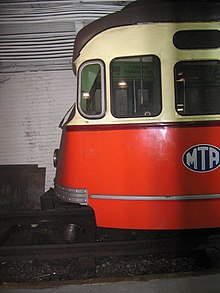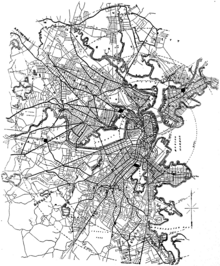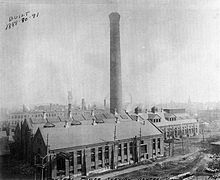Boston Elevated Railway


The Boston Elevated Railway ( BERy ) was the predecessor of the Metropolitan Transit Authority and thus today's Massachusetts Bay Transportation Authority in the state of Massachusetts in the United States . It operated trams , subways, and bus routes in the Boston area . Previously the BERy was known as the West End Street Railway .
Over time, the subway lines became today's Red Line , Blue Line and Orange Line . The only remaining trams are the various branches of the Green Line and the Ashmont – Mattapan High Speed Line , all other routes have been replaced by bus lines.
The Boston Elevated Railway operated in the following cities:
- Arlington
- Belmont
- Boston including the incorporated cities
- Brookline
- Cambridge
- Chelsea
- Everett
- Malden
- Medford
- Newton
- Revere
- Somerville
- Stoneham
- Watertown
In addition, trams operated by other companies from neighboring cities and areas ran over the tracks of the Boston Elevated Railway .
history
The beginning until 1900
BERy was originally founded as the West End Street Railway in 1887 to build a short, electrified light rail route to Brookline . In the following year the company already owned several horse-drawn trams with a total of 7,816 horses and 1,480 rail cars. As the company grew, it was considered to abolish the horses and instead use a cable embedded in the ground, which should function analogously to the San Francisco cable cars . After a visit to Frank Sprague and a tour of the system in Richmond , Henry Whitney, President of the West End Street Railway , decided to introduce an electric propulsion system.
The system was tested by Bentley-Knight on part of the track , but was dropped due to error proneness and safety concerns, particularly after some horses were electrocuted in 1889 . Comparative test series between the systems from Sprague and the Thomson-Houston Electric Company went in favor of Thomson-Houston, which was then awarded the contract to equip the entire rail system of the West End Street Railway with overhead lines . The electrified system was designated in 2004 as a "milestone in electrical engineering".
The first electric tram built by the West End Street Railway ran from Union Square via Allston and Park Square to the city center via Harvard Street , Beacon Street , Massachusetts Avenue and Boylston Street . The first trams ran there in 1889. Later, Green Line A ran almost the same route.
The last horse-drawn tram line ran along Marlborough Street in Boston’s Back Bay and was never electrified. The route was closed in 1900.
1900 to 1947
In the late 19th century, the electricity supply was still in the early stages of development and the power grid was largely still in the planning stages. Companies that needed electricity for their operation could therefore not fall back on an existing infrastructure and had to take care of suitable cabling themselves. The BERy consequently built its own power generators, which made decentralized power generation possible in Boston city center, Allston , Cambridge , Dorchester , Charlestown , East Cambridge and East Boston around 1897 . In 1904 the system generated an output of 36 megawatts and supplied 421 mi (677.5 km ) of ground-level tracks with over 1,550 vehicles and 16 mi (25.7 km ) of elevated tracks with 174 vehicles.
In 1922 the company's first bus line was established , running from Union Square via Allston to Faneuil Street . This route later became part of today's bus route 64.
The difficult overland transportation of coal from the port of Boston and the short range of the direct current system prevented expansion inland. In 1911, a large generator station was built in South Boston , which generated alternating current at a frequency of 25 Hertz , which could be transmitted over greater distances with high electrical voltage . There were smaller stations distributed throughout the network, which transformed the incoming voltage to a suitable level for the use of the vehicles. In 1931, 14 such stations were in use and the company's entire network switched to alternating current. The generator station built in 1911 remained in operation until 1981, when the MBTA decided to buy electricity from local suppliers instead of its own generation.
The first route served by trolleybuses was Route 77 (later 69), opened on April 11, 1936, from Harvard to Lechmere via Cambridge Street . Trolleybuses still run from Harvard on routes 71, 72, 73 and 77A.
The company's business was taken over by the Metropolitan Transit Authority (MTA), which later became the MBTA , in 1947.
Individual evidence
- ↑ a b c IEEE MILESTONE PRESENTATION. (No longer available online.) Formerly in the original ; accessed on February 16, 2012 . ( Page no longer available , search in web archives ) Info: The link was automatically marked as defective. Please check the link according to the instructions and then remove this notice.
- ↑ Milestones: Power System of Boston's Rapid Transit, 1889 . In: IEEE Global History Network . IEEE. Retrieved July 28, 2011.
Web links
- The archives of the Boston Elevated Railway Company from 1884 to 1967 are located at Northeastern University in Boston.


